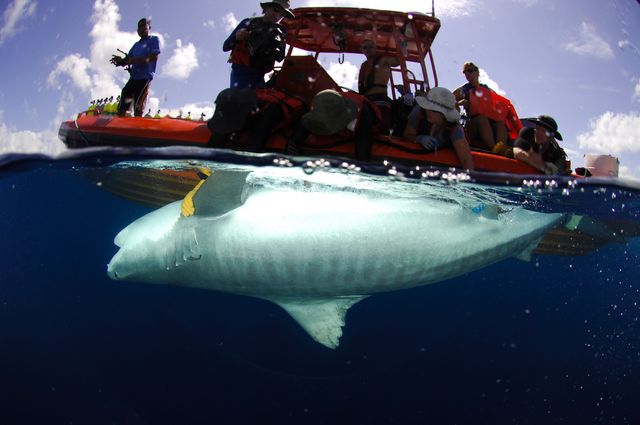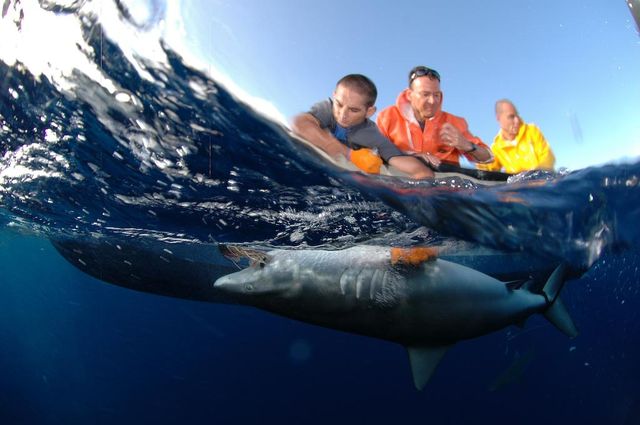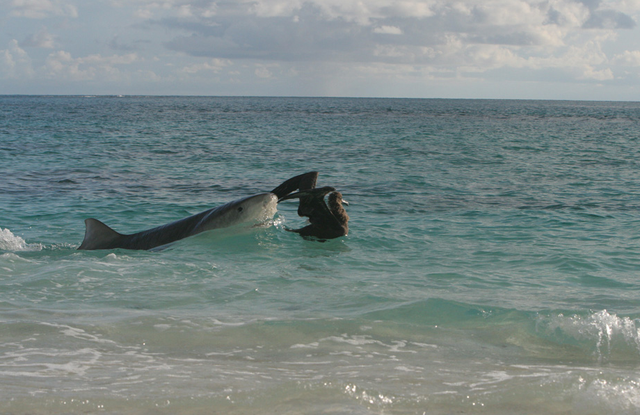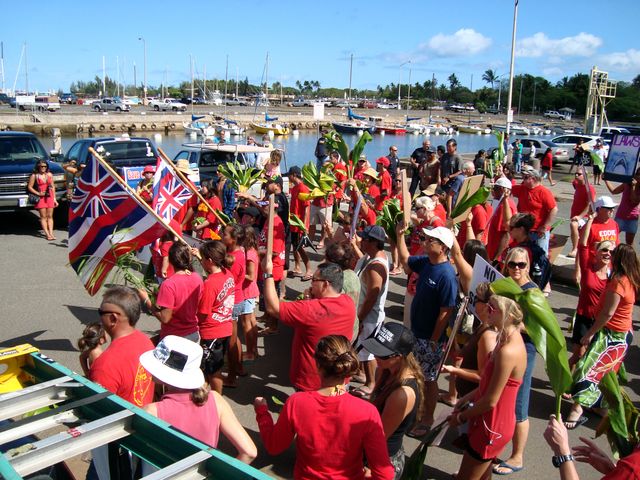
For 19 years, University of Hawaii scientist has caught sharks up and down the Hawaiian archipelago, a 1,500-mile-long chain
that runs from the Big Island northwest to Kure Atoll. He’s fished up sandbar
sharks, tiger sharks, and Galapagos sharks and tagged them with tracking
devices in the gin-clear shallows of remote atolls, in the dark blue depths around
a fish farm cage off the Big Island, over rainbow reefs where outfitters take North
Shore tourists shark diving, and in turquoise waters just offshore from any
number of the state’s white sand beaches. ��
In 1993, he arrived at the University of Hawaii green, at
least as far as big tropical sharks were concerned. In 1991, a tiger shark had
attacked and , and the state responded—as it had numerous times
before—by culling the predators. Meyer began tagging and following the animals
with his mentor, . What they found led the Hawaiian government to
to fatal shark attacks. We’ll let him tell that story
below, as well as several other stories related to his studies that have changed
our understanding of how humans and sharks interact in the aloha state.
When did you see your
first shark?
I had seen sharks while fishing as a kid, albeit small ones
found coastally in Europe. I didn’t see a tiger shark for the first time until
1993, when I came to Hawaii.
What was the context
of that?
In Hawaii, over time, there had always been a low number of
shark attacks, but back in the late 1950s there was a fatal attack on a guy
named .
As a result, the local government decided that they should instigate a shark-culling
program. That program was predicated on the concept that tiger sharks were
highly residential. In fact, they used the word territorial, which has
additional meaning to a biologist, implying active defense of space. The
untested assumption was that these sharks hang out in one area, and you could
have a program that would take out the problem animals and make the water safe.
They had a number of shark control programs in the '60s and '70s, and they killed
thousands of sharks, including from 1959 to 1976.
It was the standard MO for the state of Hawaii in those days, built on the
belief that they could make the water safer. Eventually, the programs were
stopped for more than 10 years. Then, in 1991, there was a fatal shark attack on the island
of Maui. Unusually in that case, when the emergency services showed up, the shark
was still on site. It was a large tiger shark. This particular event prompted
renewed calls for the culling of sharks. In 1993, I had just started as a graduate
student with Kim Holland, together with Chris Lowe and Brad Wetherbee, who are
now professors on the mainland. We said: “Well, hold on a second. Nobody’s ever
tested the assumption that tiger sharks are territorial or highly residential,
and this whole culling concept is built on that cornerstone.”
Holland was able to get some funds to do an initial tracking
study. We planned to go out, catch some tiger sharks, put on acoustic pingers,
and then follow them in a boat with a receiver and a hydrophone. We wanted to
figure out their short-term movements over a couple of days to see whether
there was any substance to this notion that they just lived in one area. We did
several years of research, but it was evident with the very first shark tracked
that they were not behaving in the way that people had believed. We found that
in a 24- to 48-hour period they would swim from right off the coast of Honolulu
across an open ocean channel to the next Hawaiian Island down, which is
Molokai. We did 10 active tracks from Honolulu, and all of them basically
showed this same behavior. Right there, we showed that tiger sharks were much
more mobile than people had first anticipated. That was our group’s on ramp
into tiger shark research. As a result of that first interesting empirical
finding, the state actually shuttered its control program. They finally had
some empirical data that they could use to say: “Look, there’s no evidence that
this will work because these animals are highly mobile. So, if somebody gets
attacked and we go out and fish, the chances are that shark is going to be long
gone by the time we get there.” That very first study had immediate policy
implications in the state of Hawaii.
In addition to the tracking data, my grad school colleagues
and �� had just done an in-depth analysis of
the 20 years or so of previous shark control programs. They published in Pacific Science.
They basically showed that people were still getting attacked while these shark
control programs were ongoing. The example
that I always use in presentations is Barber’s Point off the southwest corner
of Oahu. In one of the control programs, I believe during the late 1960s, they
killed 33 tiger sharks in the vicinity of Barber's Point over the course of a
year or so but someone still got bit
at Barber’s Point in November of that
year. So clearly, there were two broad lines of evidence that this shark
control stuff was worthless. One was critical tracking data showing that these
sharks were much more mobile than people believed. The second was that people
were still getting bitten at sites from which many tiger sharks had already
been removed by control fishing. So there’s just no evidence that shark culling
makes the water safer. It’s just not demonstrably effective.
That actually ties
into two things that have happened with shark attacks this year. The first is
that, after five deaths in two years, made the call to be
able to hunt great whites before they attack people. They maintain the right to
hunt a shark after it has shown a willingness to go near a popular beach if they think it is a threat. Do you
think there’s anything different about great white sharks in Australia that
would make hunting a good decision? Or is it similar to what Hawaii did years ago?
I think it’s entirely similar. White sharks are highly
mobile. If you look at what the white shark researchers are saying you are
going to hear very similar things to what I just told you. It’s understandable
if you put yourself in the place of one of these local politicians over there.
I mean, you are going to be put under enormous pressure to do something. It’s
just human nature. These guys have weathered a couple of fatal shark attacks,
but every time one happens, the camp that believes that you can make things
safer through culling is going to pile on the pressure. The political pressure
just builds and builds and builds. At some point, it just becomes politically
expedient to cave and come up with these culling programs, because, at least from
a political stance, you’re taking some kind of action.
It takes a lot more political courage to step back and say:
“Look, this is a natural risk of going in the ocean. It occurs at a very, very
low rate. All of the biological evidence suggests that if we go out there, we
will catch sharks, but we can not link that to safer waters.” It takes
tremendous political courage to do that when you have people being fatally
bitten by sharks in higher numbers than has been seen for years, or perhaps
ever. So you can understand why it happens. However, the two important words
are demonstrable effectiveness. I don’t think that any reasonable person, even
shark biologists, would have an issue with culling sharks if it was demonstrably
effective—that it really made a significant difference in the number of shark
bites. That’s never been shown with these kinds of programs with large, highly
mobile sharks. That’s really the crux of things.
The other place was Reunion Island,
where the to hunt 20 sharks after some attacks that were
probably made by bull sharks.
Again, it’s very, very difficult, perhaps impossible, to
join the dots in a way that would be satisfactory, at least from a scientific
perspective. What you tend to have is a typically low number of shark attacks,
and over time you might see some spikes in the number of bites. It doesn’t mean
there’s any fundamental change in marine ecosystems. It doesn’t mean, for
example, that a bunch of sharks have moved into your area. It might be nothing
more than natural variability, which occurs in marine or terrestrial systems.
Nature is an inherently noisy system. Part of the noise is variation in stuff,
including the number of people that get bitten by sharks. That said, if you are
a local politician and you are suddenly confronted with a flurry of shark bites,
particularly if some of them are fatal, and if you are heavily reliant on
tourism, then you find yourself in a difficult position. On one hand, you may
have biologists telling you there may be nothing going on here and nothing that
you can do. On the other hand, you are an elected official and your job is to
do something. I think the political need to take some kind of positive action drives
these culling efforts. But I think that whether or not you cull, those spikes
will go away.
You have also . Can you tell me what you discovered?
We first became interested in the possible impact of ocean
fish farms on shark behavior when we started receiving anecdotal reports of the
fish cages attracting sharks. There were two main aquaculture operations in
Hawaii at the time we did this work. One of them was off the south coast of
Oahu. The other one was off the Kona Coast of the Big Island. We had heard from
people that if you went out to these cages you would see a lot of sharks, which
is unusual in the main Hawaiian Islands. Although there are plenty of sharks
around Oahu and Hawaii, you rarely see them at typical scuba depths. The first thing we did was go out and dive at the
fish farm site off the south coast of Oahu.
Sure enough, there were a ton of sandbar sharks under the cages. It’s quite an amazing place. There are these
giant futuristic fish cages anchored in 150 feet of water like something out of
Close Encounters or War of the Worlds and when you get
underneath them, suddenly you’re confronted with all of these sandbar sharks.
We went to both fish cage locations and we fished and tagged sandbar and tiger
sharks. Then we instrumented the cage locations.
We found that sharks spent more time at these cages than
they did at other reef locations around the coastline. It’s especially true of
the sandbar sharks because they do show a degree of residency and are less
mobile than the tiger sharks. Sandbar sharks would often be around the cage all
day long and in the general vicinity of the cage at night. They were showing diel
migrations that we see fairly commonly in fishes and other animals,—they’ll use
one location by day and then go to another location at night. We don’t typically
see that behavior in tiger sharks. Right there and then we could see that for
some reason that sharks like to associate with these cages. It might have
nothing to do with the fish farming operations themselves. The sharks are apparently
not eating the fish inside the cages or the pelleted food. It may just be that this
large three-dimensional structure located in very, very flat terrain is
appealing to sharks and fishes in a way similar to a large shipwreck or an
artificial reef. What is the actual mechanism that drives that? We don’t know.
Why do some things like to come and hang out by these three-dimensional
structures? It may be that those three-dimensional structures build their own
little ecosystem and it’s a good place to find food. Or, it might just be a
rendezvous site. A place that is obvious that you can come back to every day and
find your conspecifics there.

Are there other
coastal developments that you’ve seen that have changed the migration or
gathering patterns with sharks?
There’s no evidence that other current coastal developments
have acted the same way as these fish cages. Detection patterns from our
listening receivers, deployed in a broad variety of habitats around the
Hawaiian Islands, from the shallowest reef environments to buoys in very deep
water 20 miles offshore, show that although there are other areas that sharks favor,
they spend less time at these other sites than around the fish farming cages.

You also went out to a
very remote location, French Frigate Shoals in the Northwestern Hawaiian Islands,
and . There you saw the same individuals coming back to feed
on nesting seabirds in June and July of every year. How do they do this?
In the case of the tiger sharks eating albatross fledglings,
each shark must first discover this phenomenon.
To do this they have to swim by the nesting beaches during the few weeks
each summer when fledging occurs. This
probably initially occurs purely by chance. Even sharks with well-defined patterns of movement behavior seem to
spend some of their time exploring new areas. We don’t know exactly what drives sharks to explore new habitats but this
exploratory behavior must result in some sharks stumbling across fledging
seabirds for the first time. When they do it’s a feeding bonanza. Those birds
are completely naïve. They’re making their maiden flight. Some of them are
flopping down into the water, only tens of yards from their nesting beach. It
is easy pickings for a big tiger shark and there’s a lot of incentive for them to
come back again and do the same thing.
What is really fascinating is that some of these sharks,
based on the detection patterns that we have, only come to French Frigate
Shoals during the few weeks that fledgling occurs and then they leave. During
those few weeks, pretty much all those sharks do is visit places where the
birds are fledging, which are just little sandy islands dotted around this
atoll that’s 30 miles across. Not only
do the tiger sharks apparently have some sort of cognitive map that tells them where
food resources are available, but they must also have some sort of internal
clock perhaps based on environmental cues that leads them to say, “OK, it’s
June the 13th, I better start swimming down to French Frigate Shoals
because in three days there’s going to be fledgling seabirds available.” We don’t
know exactly how they’re doing it, but we suspect in broad terms that they have
these capabilities: an internal clock, a resource map, and an ability to
navigate. They are able to put these things together and move fairly directly
to come to these places of interest at the right time.
To add a further twist, we also know that there are other
tiger sharks present at FFS during fledging season that show no evidence of
targeting albatross. Some of these tiger sharks are there year-round, and roam very extensively throughout the atoll but lack the characteristic
detection patterns shown by bird-eating sharks.
So you have the same
species of shark in the same area and they may have a completely different
diet?
Yes. It may be that some tiger sharks do eat birds, but they
may not have discovered this seasonal fledging bonanza. Or, they have some
other foraging strategy that works well for them so they do not need to hang
out and eat fledgling albatross. And if you think about it, you can see how
that might arise. Imagine two tiger sharks in the same litter. As soon they’re
dropped by their mother they go separate ways, and over the five to 10 years
it might take to grow to the size where they may eat seabirds, they have very
different foraging experiences. And so
ultimately, after five or 10 years, their respective cognitive map of
resources may look very different.
Is there anything you
think that I haven’t asked? I know it’s a big year for attacks in Hawaii with
at least eight, but no fatalities.
Thank goodness for the lack of fatalities but this recent
spike in numbers of bites has certainly generated a lot of media and public
interest. The first thing I try and get
across to people is that these spikes may be nothing more than natural
variability arising from chance. I can’t emphasize that enough. Although this
year there was a three-fold increase in attacks, compared to 2011 when we had
three, it does not mean there has been any kind of fundamental changes in ocean
ecology or shark behavior. Although it’s a three-fold increase in absolute
terms, we’re talking about three versus nine. From a statistical perspective,
scientifically, we just can’t do very much with those low numbers.
Another issue which has generated a lot of heat here in
Hawaii and elsewhere is shark cage diving ecotourism. These activities have
proven hugely controversial. We’ve done a fair bit of work on the one here on
Oahu, including a meta analysis of logbook data and tracking long-term
movements of sharks captured at the cage diving sites—the takeaway message is
that there’s absolutely no scientific evidence whatsoever that the existing
operations off Oahu are a threat to public safety, which has been people’s
major concern.

Now, it is important to remember that shark diving ecosystem
tour operations are not all created equal. Some have divers in cages in deep water, some
have divers out in the open on coral reefs. Some operations feature relatively small reef sharks, others large
sharks. Some companies use sites far from
human populations, others operate in areas used by other recreational scuba divers,
or close to popular swimming and surfing beaches. All of these things may influence the
potential risk to public safety of these activities, but as far as we can tell,
the ones that are operating off Oahu are no threat to people. Also, they do not seem to be significantly
disrupting natural patterns of shark behavior.
The Oahu cage diving operations rely on sandbar and
Galapagos sharks, aggregating at the companies
offshore ecotourism sites, but those sharks are not there permanently. They leave those sites every night, and are
absent for longer periods during mating season. So whatever draw the fish farming and shark ecotourism
sites have, it is not strong enough to disrupt shark natural mating migrations.
I know we’ve written
about great whites and cage diving off South Africa. What about the tiger
sharks off of Hawaii?
Tiger sharks they see very, very rarely. I think they account for one or two
percent of the sharks they see. They see almost exclusively Galapagos and
sandbar sharks. Neither of those species have a significant track record of
biting humans. If you look at historic shark attack records there’s maybe one
or two attacks attributed to sandbar sharks and maybe one attack attributed to a
Galapagos shark. So these are not dangerous species, but there was a period when
cage diving ecotourism was the hottest shark topic in Hawaii, and it got hugely
ugly. There were big protests by the ports where the tours operate. One of the
operators had three of his boats burned in arson attacks because people
believed that these operations were increasing their risk of being bitten by
sharks. We found no evidence of that.
So there are things
to be learned from tagging not just in terms of attacks, but in terms of
fishing, tourism, and across the board?
Yes. Obviously the natural ecology is the thing that tends to
appeal most to researchers because often little or nothing is known about a
particular species' movements before you start a tagging study. We
get to use cool toys to figure out what is going on and tell the story of the
natural lives of these animals. At the same time, understanding the spatial
dynamics of these animals is important for interpreting how we are interacting
with and perhaps disrupting ocean processes. Is there anything about the
spatial dynamics of these animals that could help us understand why these
attacks happen? The answer could be no, but the only way we’ll know is if we
have those movement data.
We also have many kinds of coastal developments that impinge
on, or alter, the marine environment. Understanding the movements of sharks and
other species can allow us to do some forecasting. Not only can we perhaps get
some understanding of how existing human activities may influence or be
influenced by the movements of marine animals, we might also be able to make
some forecasts about how proposed future development might influence the
movements of animals and perhaps disrupt marine ecology in ways that are
inconvenient to humans.
This is the fifth dispatch in a series about sharks.
Part 1: Surviving a Great White Shark Attack
Part 2: George Burgess on the Science of Shark Attacks
Part 3: George Burgess on Shark Finning and Conservation
Part 4: How You Can Track a Great White Shark on Your Phone
—Joe Spring